
HOME





HOME
|

|

|

|

|
|
P R O F I L E |
||||
|
 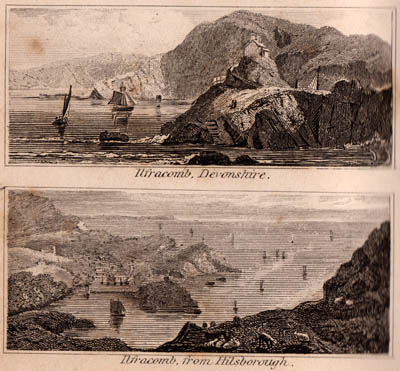 Beach Tunnels
Beach TunnelsBath Place Ilfracombe Devon United Kingdom EX34 8AN Telephone: 01271 879882 In "A Guide to the Watering and Sea Bathing Places" dated 1846, mid 19th century Ilfracombe is described as a sea port town, delightfully situated on the north coast of Devonshire, near the mouth of the Bristol Channel. (see picture right) It has a pier, within which is a large commodious basin, where ships of any burden may ride in perfect safety, in the most violent storms. The harbour forms a semicircle, surrounded with hills, from the summits of which there are many delightful views; and on a clear day the coast of Wales and the island of Lundy, may be distinctly seen. Outside the pier are several coves, admirably adapted for bathing, for which purpose there are many convenient machines. To the west of the harbour occur a number of secluded beaches or coves at the foot of the cliffs that were once supposedly only accessible by boat, although caves appear to have likely provided limited access to the shore. That is until 1819 - 1823 when a series of tunnels through the hillside were dug. These made the beaches accessible to the public and were used for men's and women's separate bathing facilities. This was at a time when sea bathing was for health rather than leisure. At the inland entrance to the tunnels, facilities were soon established thereafter and the town developed as a health and leisure resort. 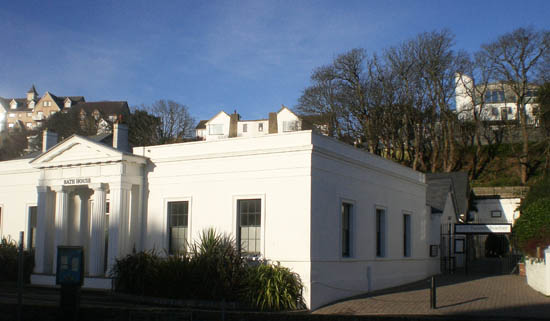
The Bath House with the Tunnels entrance right.One particular building at the mouth of the tunnels was The Bath House. Styled after the ancient Athenian Treasury at Delphi in Greece, this structure once housed sea water baths. In 1836 the Ilfracombe Sea Bathing Company erected the elegant new bath-house where both hot and cold sea water baths were available for health and hygiene. Baths were taken within a labyrinth of small enclosures beneath the house. Sea water was fed from the Tunnels Beaches on the other side of the hill via a wood fuelled boiler that in turn powered a pump. The site of the pump house can still be seen through the tunnels.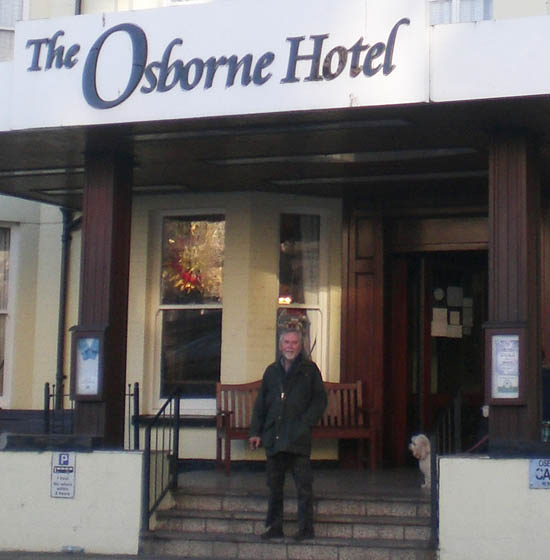
Dr Bruce Osborne of the Great British Grotto Grading scheme stands outside his namesake hotel.Another local building that was contemporary with the development of Ilfracombe as a health and leisure tourism resort was the Osborne Hotel. It is located just opposite The Bath House, near the entrance to the tunnels. The Hotel has been owned by the Cox Family for over 36 years. Initially four Victorian terraced houses; it was turned into a hotel in 1850. The cutting of the tunnels for beach access had prompted the hotel development in the vicinity.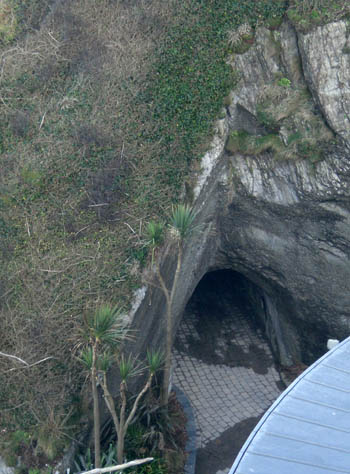
Tunnels giving access to the beaches.Dug by Welsh miners, the total length of the tunnels is over 160 metres. It took 2 years to carve the tunnels and over 960 cubic metres of rock had to be removed. The miners were paid 8d per day and their axe marks are still visible throughout the walls of the tunnels. The recesses in the first tunnel housed candles and later oil lamps. In all, 6 tunnels were carved, 5 still remain, 4 are used.An 1839 guidebook explained the rules for the use of the beaches via the tunnels: "The westward part is allotted to gentlemen, while the eastward is by custom left to the ladies and is carefully guarded against intrusion. Machines and bathing women are in attendance, and every information respecting the proper time to bathe will be given at the Baths". Segregated bathing was tightly controlled; a bugler sat between the ladies and the gentlemen's pools - if a man attempted to spy on the ladies, the bugler would blow an alarm call and the man would be arrested. Segregated bathing lasted 82 years before mixed bathing became acceptable. Originally there were three pools at Tunnels Beaches, but unfortunately the ravages of winter storms has resulted in only the ladies pool and part of the smallest pool surviving. That is not the full story however. Once an isolated fishing harbour, Ilfracombe was the location of smuggling and the caves and coves that pre-empted the tunnels were ideal for discrete night time drops of cargoes to avoid the duties payable. Merchant shipping in the Bristol Channel meant that tobacco and other dutiable cargoes could be offloaded before the docks at Bristol were reached. 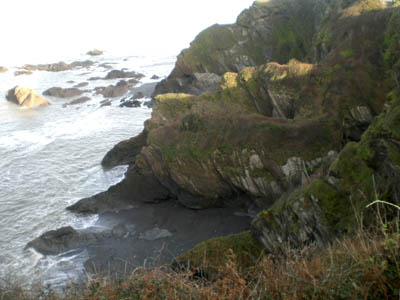
The isolated coves, once ideal for smuggling.Hesketh in "Devon Smugglers" (2007) confirms that smuggling abounded along the coast up to the 1850s and the front cover of his book illustrated below shows nefarious activities taking place in the vicinity of a man made tunnel in an isolated cove.On pages 29/30 Robert Hesketh outlines smuggling on nearby Lundy Island, describing a fortified smuggling depot. Brandy Cove just west of Ilfracomb's harbour was used by smugglers, as the name suggests. And just east a cave at Samsom's Bay was used by a smuggler of that name. Chambercombe Manor on the outskirts of Ilfracombe is allegedly haunted, such tales being created by smugglers to avoid night time contact with people scared to go out at night. Smuggling or the Free Trade as it was known, was a major income source for coastal communities until duties were reduced and seaside tourism replaced it in the mid 19th century. 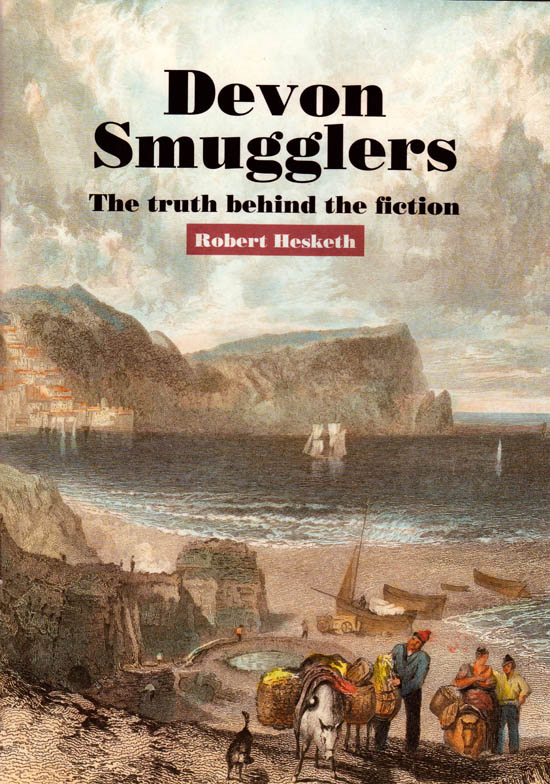
"Devon Smugglers" is available from the Tourist Information Centre. For more details of the fascinating history of the tunnels together with pictures of their interiors click on website below. Email: info@tunnelbeaches.co.uk (click here to send an email) Website: Click Here ADDITIONAL INFORMATION  
GREAT BRITISH GROTTO GRADING
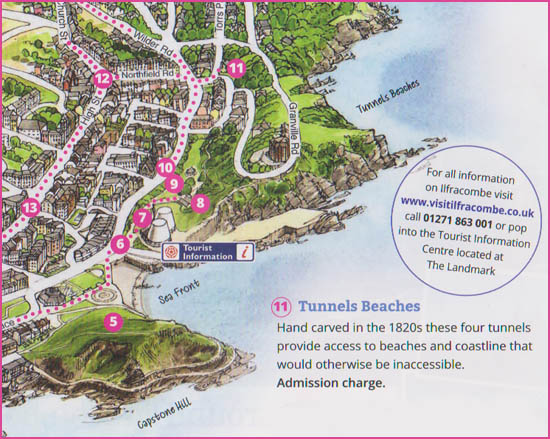
CONSTRAINTS Open set times only FACILITIES Access on Foot, Entry Fee, Grottoes - more than one, Part of a larger tourism attraction, Restaurant/Food, Toilets, Weddings venue LANDSCAPE Coastal, Upland, Urban REGION England - Southern THE FEATURES PRESENT +Cared for and maintained in good condition, +Dark and mysterious chambers and cave like spaces, +External rock structures, either real or simulated, +Internal stonework that is natural, recycled or simulated to give a subterranean decor, +Stunning setting and location, +Viewing points from within to an intriguing landscape outside, GRADED SIX |
||||
|